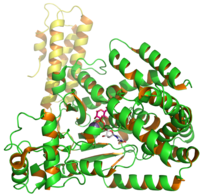
A small molecule inhibitor screen reveals calcium channel signaling as a mechanistic mediator of Clostridium difficile TcdB-induced necrosis.
Sign Up to like & getrecommendations! Published in 2020 at "ACS chemical biology"
DOI: 10.1021/acschembio.9b00906
Abstract: Clostridiodes difficile is the leading cause of nosocomial diarrhea in the United States. The primary virulence factors are two homologous glucosyltransferase toxins, TcdA and TcdB, that inactivate host Rho-family GTPases. The glucosyltransferase activity has been… read more here.
Keywords: small molecule; screen; tcdb; tcdb induced ... See more keywords

Intestinal bile acids provide a surmountable barrier against C. difficile TcdB-induced disease pathogenesis
Sign Up to like & getrecommendations! Published in 2023 at "Proceedings of the National Academy of Sciences of the United States of America"
DOI: 10.1073/pnas.2301252120
Abstract: Significance Clostridioides difficile is the leading cause of hospital-acquired diarrhea worldwide. While TcdB, the primary virulence determinant of C. difficile, is known to be required for the intestinal symptoms associated with infection, asymptomatic carriage of… read more here.
Keywords: tcdb; difficile; bile acids; acids provide ... See more keywords

Lectin Activity of the TcdA and TcdB Toxins of Clostridium difficile
Sign Up to like & getrecommendations! Published in 2018 at "Infection and Immunity"
DOI: 10.1128/iai.00676-18
Abstract: Clostridium difficile is a major cause of hospital-acquired antibiotic-associated diarrhea. C. difficile produces two cytotoxins, TcdA and TcdB; both toxins are multidomain proteins that lead to cytotoxicity through the modification and inactivation of small GTPases… read more here.
Keywords: tcdb; clostridium difficile; tcda tcdb; tcdb toxins ... See more keywords

Designed Ankyrin Repeat Protein (DARPin) Neutralizers of TcdB from Clostridium difficile Ribotype 027
Sign Up to like & getrecommendations! Published in 2019 at "mSphere"
DOI: 10.1128/msphere.00596-19
Abstract: We report the engineering and characterization of designed ankyrin proteins as potent neutralizers of TcdB toxin secreted by a hypervirulent ribotype 027 strain of Clostridium difficile. We further show that although TcdB toxins from both… read more here.
Keywords: designed ankyrin; clostridium difficile; tcdb; ribotype 027 ... See more keywords

Clostridioides difficile antibody response of colorectal cancer patients versus clinically healthy individuals
Sign Up to like & getrecommendations! Published in 2020 at "Bioscience of Microbiota, Food and Health"
DOI: 10.12938/bmfh.2020-010
Abstract: Dysbiosis, defined as an imbalance in the gut microbiota caused by too few beneficial bacteria and an overgrowth of bad bacteria, yeast, and/or parasites, is now being associated with several diseases, including the development of… read more here.
Keywords: igg; clostridioides difficile; anti tcdb; crc ... See more keywords

Difference in Mono-O-Glucosylation of Ras Subtype GTPases Between Toxin A and Toxin B From Clostridioides difficile Strain 10463 and Lethal Toxin From Clostridium sordellii Strain 6018
Sign Up to like & getrecommendations! Published in 2018 at "Frontiers in Microbiology"
DOI: 10.3389/fmicb.2018.03078
Abstract: Clostridioides difficile toxin A (TcdA) and Toxin B (TcdB) trigger inflammasome activation with caspase-1 activation in cultured cells, which in turn induce the release of IL-6, IFN-γ, and IL-8. Release of these proinflammatory responses is… read more here.
Keywords: ras subtype; tcda; glucosylation; toxin ... See more keywords

The Compound U18666A Inhibits the Intoxication of Cells by Clostridioides difficile Toxins TcdA and TcdB
Sign Up to like & getrecommendations! Published in 2021 at "Frontiers in Microbiology"
DOI: 10.3389/fmicb.2021.784856
Abstract: The intestinal pathogen Clostridioides (C.) difficile is a major cause of diarrhea both in hospitals and outpatient in industrialized countries. This bacterium produces two large exotoxins, toxin A (TcdA) and toxin B (TcdB), which are… read more here.
Keywords: tcdb; clostridioides difficile; compound u18666a; intoxication cells ... See more keywords